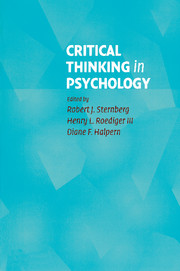Book contents
- Frontmatter
- Contents
- List of Illustrations and Tables
- List of Contributors
- Preface
- 1 The Nature and Nurture of Critical Thinking
- 2 Evaluating Experimental Research
- 3 Critical Thinking in Quasi-Experimentation
- 4 Evaluating Surveys and Questionnaires
- 5 Critical Thinking in Designing and Analyzing Research
- 6 The Case Study Perspective on Psychological Research
- 7 Informal Logical Fallacies
- 8 Designing Studies to Avoid Confounds
- 9 Evaluating Theories
- 10 Not All Experiments Are Created Equal
- 11 Making Claims in Papers and Talks
- 12 Critical Thinking in Clinical Inference
- 13 Evaluating Parapsychological Claims
- 14 Why Would Anyone Do or Believe Such a Thing?
- 15 The Belief Machine
- 16 Critical Thinking and Ethics in Psychology
- 17 Critical Thinking in Psychology
- Author Index
- Subject Index
- References
6 - The Case Study Perspective on Psychological Research
Published online by Cambridge University Press: 05 June 2012
- Frontmatter
- Contents
- List of Illustrations and Tables
- List of Contributors
- Preface
- 1 The Nature and Nurture of Critical Thinking
- 2 Evaluating Experimental Research
- 3 Critical Thinking in Quasi-Experimentation
- 4 Evaluating Surveys and Questionnaires
- 5 Critical Thinking in Designing and Analyzing Research
- 6 The Case Study Perspective on Psychological Research
- 7 Informal Logical Fallacies
- 8 Designing Studies to Avoid Confounds
- 9 Evaluating Theories
- 10 Not All Experiments Are Created Equal
- 11 Making Claims in Papers and Talks
- 12 Critical Thinking in Clinical Inference
- 13 Evaluating Parapsychological Claims
- 14 Why Would Anyone Do or Believe Such a Thing?
- 15 The Belief Machine
- 16 Critical Thinking and Ethics in Psychology
- 17 Critical Thinking in Psychology
- Author Index
- Subject Index
- References
Summary
The case study approach has a rich history in psychology as a method for observing the ways in which individuals may demonstrate abnormal thinking and behavior, for collecting evidence concerning the circumstances and consequences surrounding such disorders, and for providing data to generate and test models of human behavior (see Yin, 1998, for an overview). Nevertheless, the most typical methods for scientifically studying human cognition involve testing groups of healthy people – typically, college undergraduates. In their statistics and research methods courses, psychology students are trained to study the effects of manipulations that are significant across groups of participants despite considerable variation at the level of the individual. They are trained to be skeptical of reasoning from an individual case that goes against the general trend, and to be suspicious of the compelling anecdote that may be introduced to defend some position about how cognition or social interactions might work. Given this state of affairs, are the practitioners of the case study approach misguided, or can valid conclusions be drawn from findings with one patient? Can case reports that detail a client's symptoms and reactions to psychotherapy constitute scientific data? What about case studies that investigate how brain damage affects particular cognitive processes? The goal of this chapter is to demonstrate how single-case-study approaches in clinical psychology and cognitive neuropsychology have contributed to the advancement of theories and models of human cognition and to address the common concerns that researchers often have about case study methodology.
- Type
- Chapter
- Information
- Critical Thinking in Psychology , pp. 90 - 109Publisher: Cambridge University PressPrint publication year: 2006



